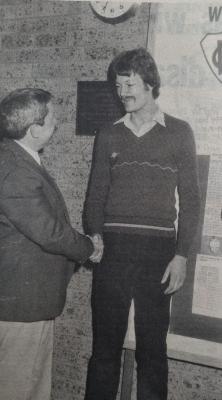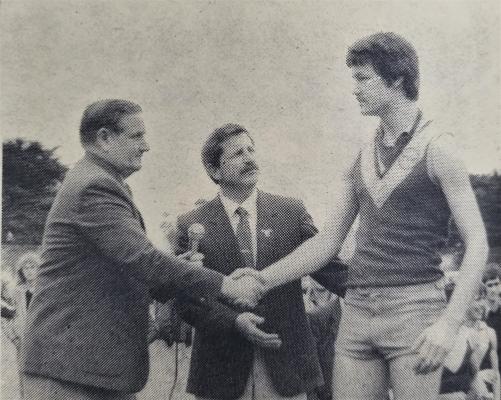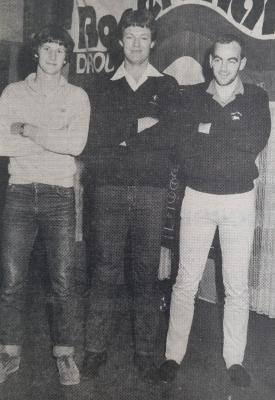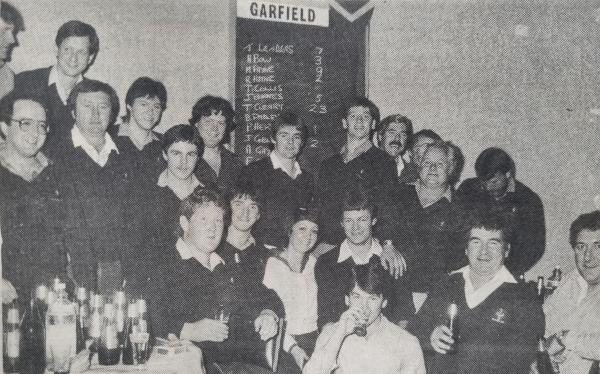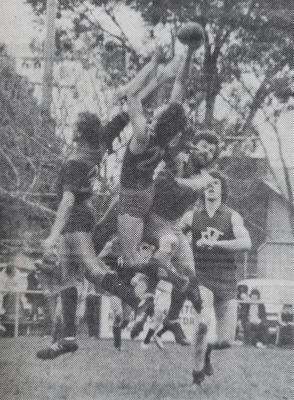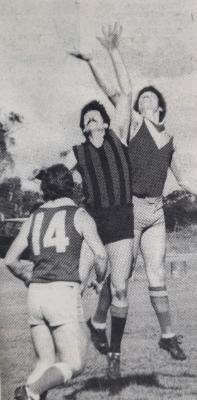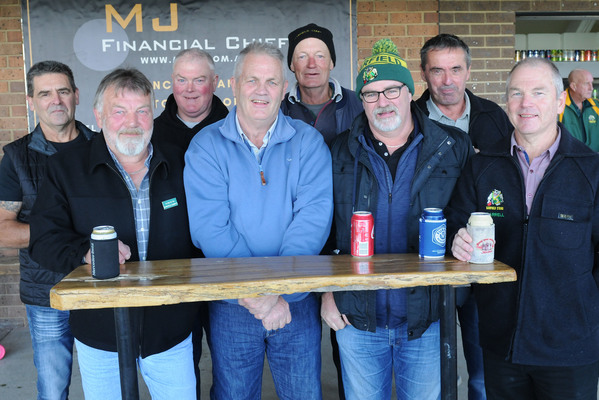
By David Nagel
Tom Cleary has many great memories of a fantastic football journey that banked him a cherished premiership with Garfield and back-to-back Breheny Medals as the best and fairest player in the West Gippsland Football League (WGFL).
Cleary was the pre-eminent ruckman in the WGFL from the late 70’s through to mid-80’s and built his enviable reputation on fair play, a huge leap, and having the cleanest pair of hands in the business at both the Bunyip and Garfield footy clubs.
But it’s a treasured piece of chewing gum, and the absolute joy of watching others benefit from his gifted ruckwork that are his most unique memories, and give a deeper insight into where his passion for the game began and the absolute mastery of his craft.
Tom Cleary was born in the second week of January, 1957, right in the heart of West Gippsland, at the West Gippsland Hospital in Warragul.
The future West Gippsland icon lived just behind the future site of another, with his mum Gaye and dad Tom living on a dairy farm on Brew Road in Garfield North…just behind where Gumbuya Park would first spring from the ground in 1978.
The Cleary family home was a busy one, with Tom the fifth of eight siblings with Genevieve, Ted, Mick, Angela, Tom, Bernard, Eleanor and Jim making up the clan.
“When mum and dad first moved there it took two years to get the power on and then we got running water two years after that,” Cleary explained.
“It was about a four kilometre walk to the Garfield North Primary School which kept us pretty fit and active.
“I went to St Pat’s in Pakenham for a year, but then mum and dad sold the farm and bought a nice property in Iona. I went to St Joseph’s Primary School in Iona after that.
“We were just typical kids.
“We couldn’t wait to get outside in the mornings and play footy and cricket and we hated coming inside at night.”
Those kicks of the footy on the family farm certainly triggered something within the Cleary boys, with three of the brothers, Mick (who tragically passed away just three weeks ago), Bernard and Tom, all winning senior best and fairest awards at Bunyip.
How they got to Bunyip, from Garfield, we will point out shortly – but Mick’s best and fairest win in 1974, and Bernard’s three-peat in 1977, 78 and 79 were the perfect precursor to Tom’s three-consecutive awards from 1980 to 1982.
The Cleary boys won seven best and fairest awards at Bunyip in nine years and Bernard would also go on to play a key role at centre-half back in Cora Lynn’s 1986 premiership team!
The Cleary boys were also very handy cricketers, winning multiple premierships for Garfield/Bunyip when ‘The Combine’ joined the Warragul District Cricket Association.
“Ted was captain, Mick was the opening bowler, Bernard was opening bat, and I was a specialist fine leg,” Tom says with a laugh.
“I just bowled a few leggies and batted middle order.”
Tom Cleary’s first taste of football was an exhilarating experience, watching superstar full-forward Jim ‘Frosty’ Miller kick goals for fun for Garfield through the 1960’s.
“I remember Garfield won a premiership, 1963 I think it was, and I was chewing some gum when I got home from the grand final,” Cleary recalled.
“Mum said ‘Where did you get that from?’
“I said, ‘Frosty Miller gave it to me’…I remember the three-quarter-time huddle of the grand final I was holding his hand and he gave me his chewing gum.
“I reckon I chewed that gum for four days straight (laughs)…he was everyone’s hero.
“Just the number of goals he kicked was pretty impressive for a kid back then…I idolised him and all the kids at Garfield aspired to be like him.”
Eldest brother Ted was also playing for the Garfield thirds.
But, being a boarder at St Bede’s in Mentone, Ted was unable to attend a compulsory Sunday training session at Garfield and wasn’t selected in the thirds team for the following week.
Ted’s dad Tom was not impressed.
“Dad thought Ted had a reasonable excuse not to train so he packed us all up, like the Beverly Hillbillies, and we all headed off to Bunyip,” Cleary says with a chuckle.
“I remember our Bunyip junior team not being very successful. Drouin kicked 40 goals to one point one day, but we enjoyed the footy.
“I was 13 at the time when I started, a tall skinny kid who could jump a bit and I was lucky enough to win a third’s best and fairest at Bunyip in 1973.
“I would play footy for the thirds and then boundary umpire for the seniors in the afternoon.”
The senior team at Bunyip would become home for Cleary for nine years, playing at the club from 1974 to 1982…with the club never really threatening to break a premiership drought that extended back to 1945.
“We didn’t play finals and I remember at times we were quite uncompetitive,” Cleary remembers.
“Ray Steenholdt was my first coach and it was pretty big when Max Papley came to coach, but we really struggled for success.
“Bunyip and Garfield almost combined at one stage, but that fell through, and then Bunyip joined the Ellinbank and District Football League in 1982.”
Cleary would stay on for the 1982 season – winning his third best and fairest on the trot – before Garfield came knocking!
“A good friend of mine, John Giblin, he played at Garfield, we went to school together, and he was the one who first floated the idea of moving across to Garfield,” Cleary explained.
“At first I said ‘don’t be so bloody stupid.’ Joe Lenders was coach at Garfield at the time and even he told John that he would never get me to leave Bunyip.
“It was difficult, but I knew a few people at Garfield and they were right up there, but had a habit of bowing out in finals.
“I had a good think about it and decided to go.
“I put in three clearances and Bunyip knocked them all back so I had to appeal their decision, which wasn’t ideal.
“I went to the appeal, on the Friday before the first game of ’83.
“The clearance was granted but I wasn’t allowed to play against Lang Lang because the paperwork didn’t go through in time.
“The move caused a little bit of bad blood but most of it was in jest.
“At the Bunyip pub the barman would say, ‘Why don’t you go down to Garfield and drink with your mates down there.’ It was pretty good natured…but they weren’t very impressed that I left.”
Cleary joined Garfield for the 1983 season but took some time to settle in to his new surroundings.
“I was a bit hesitant at first, very nervous, and felt like an outsider to begin with but they were terrific young blokes and a great club,” Cleary said of Garfield.
“My first game was against Drouin at Drouin.
“We were in front at half time and the president, Chris Soumilas, came up to me and gave me some encouragement.
“We won and he came back to me after the game and said ‘How was that, Tom?’
“I said I’ve played against Drouin for 13 years and never played in a winning side.
“He looked me straight in the eye and said ‘Welcome to Garfield.’
“From that moment on I felt welcomed at Garfield. It was just the way he said it, the way he looked me in the eye…they were exactly the right words at the right time.
“It was a bit hard to begin with but you put a few good games together and you do start to feel appreciated.”
Cleary and Garfield would both have a magnificent 1983 season, Cleary winning the first of back-to-back Breheny Medals while Garfield would shake the monkey off its back by winning the premiership under the inspirational leadership of Lenders.
“He was our leader, we all looked up to him because he had such a successful career himself,” Cleary said.
“I had played against him, respected him, admired his will to win, and that was the attitude that permeated through all those blokes at Garfield.
“I was 26 in my first year at Garfield so would like to think I had the respect of the young blokes as well.”
“Murray Payne was 20 years of age, Timmy Collis, Brendan Fawkner, Glen Murtagh, Neville Bow, that was his first year, he was 16 years of age.
“They all lived in Garfield, they lived and breathed footy and I admired all of those young blokes for that. That’s what got us through that year…they were brilliant.”
The build up to the 1983 grand final against Drouin saw Cleary thrust into the spotlight, with Breheny Medal night a big occasion in the day.
Cleary polled 21 votes, five votes clear of his nearest rival, Geoff Webster from Nar Nar Goon.
“I remember the night clearly, it was at the Nar Nar Goon Community Centre and I was way behind in the early stages of the count,” Cleary said.
“But we got there in the end and one of the things you had to do after winning the medal was draw the raffle.
“You wouldn’t believe it, I drew my own ticket out and won a dinner for four at the Caravan Park, just before you get into Beaconsfield on the left, they had a restaurant there.
“Bill Doherty (WGFL Life Member and Past President at the time) couldn’t believe it.”
That night began a huge build up to Garfield’s quest for that elusive premiership.
“We had breakfast on grand final day at the Garfield Hotel,” Cleary recalled.
“Drouin had beaten us by four goals in the second semi-final and then we fell over the line against Kooweerup in the prelim at Nar Nar Goon by four points…we get Drouin again.
“After breakfast at the hotel, Murray Payne’s father, Tim Payne, came up to me and said, ‘if anything happens early you go and stand next to ‘Boots, who was the central umpire, Peter Hayward.
“Sure enough at the four-minute mark all hell broke loose and it got quite physical out there for a few minutes.
“But by quarter time we were six or seven goals in front – and we were home half way through the third.
“We had 22 good players that day. Glenn Murtagh was brilliant in the centre, Peter Hermans was our best finals player that year, he was full back.
“Murray Payne kicked seven and Kevin Jose kicked six, what a wonderful player he was to play and train with as well.
“I was only at Garfield for three years, but it’s fantastic to have that bond. I still see the blokes around the traps and we talk about those days…memories are a great thing to have.”
Cleary’s elevation to being the best player in the competition coincided with a change in attitude when he made the switch from Bunyip to Garfield in 1983.
A laconic approach was replaced with a new-found passion for the game, even for the training side of things.
“I don’t like talking about it that much, because it’s an indictment on me, but my attitude did change when I went to Garfield,” Cleary said honestly.
“At Bunyip, it was very relaxed, if you couldn’t or didn’t want to train you didn’t, and things just rolled on from there…’I couldn’t be bothered going training tonight’…that type of thing.
“But at Garfield I loved going to footy training and the realisation that we had a bloody good side helped with motivation, I think.
“I was working on a vegetable garden with my future father-in-law, was fit as a mallee bull, working on paddocks for six or seven hours a day and then going to footy training…you just felt fit and that obviously helped a lot too.”
Cleary would add a second Breheny Medal in 1984, with his huge leap, great tap work, and ability to read the game – dropping in across half back – making him a huge stumbling block for opposition clubs to overcome.
But it was his ruck craft, feeding a talented midfield that he enjoyed most.
“I had a pretty big leap and used to palm the ball pretty accurately, and when you’ve got players like Glen Murtagh, Kevin Jose, Joe Lenders, Murray Payne, Timmy Collis around you in the centre, it gave me plenty of targets,” he said with a chuckle.
“You palm it to one of them, on the move, and you were away, and there’s nothing better as a ruckman than standing in the centre of the ground and watching the midfielders take the ball forward and saying to yourself, ‘That’s how it should work’, that was very satisfying.”
Despite his individual success, Cleary said he never felt intimidated or overly targeted by opposition players.
“I got along with all the opposition players very well and maybe that came from the time we spent together playing interleague with West Gippsland,” he said.
“To have a couple of beers with players like Greg and Rod Batt, Trevor Thompson, it was great to do that after interleague training and it built respect throughout the league.
“Plenty of rough stuff still went on, but I never felt targeted.”
Cleary loved his interleague experiences, taking on the best from around the state, winning and losing some tough battles. He was named best on ground in a grand final against Latrobe Valley…who was loaded with VFL/AFL talent.
“Latrobe Valley had Greg Dear in the ruck, Tommy Alvin at full back and Brian Royal as their rover, they were a powerful team,” he recalls.
“But the highlight for me was when we jumped on a bus and went to Port Arlington to play the Bellarine Peninsula and won by a point.
“Russell Brereton was coaching Tooradin, a dangerous forward-midfield type, and he took a big mark and kicked a late goal to win it for us by a point.
“I remember the bus trip home because it was Joe Lenders’ 30th birthday that day and also Murray Payne’s 21st as well…that was a wonderful trip home.
“And one of the best players I played against was Kevin ‘Stretch’ Beilby, and I loved interleague because I got to play with him instead of against him.”
Cleary was still one of the best players in West Gippsland in 1985, but recently married, he bought a house in Mulgrave that year and started a new job in town as well.
He commuted from Melbourne to Garfield for his football, but with travelling becoming tedious in the second half of the year his form slowly dropped away.
He would still finish high-up in the Breheny Medal count, before deciding on a switch of scenery in 1986.
“In 1985, we couldn’t make finals towards the end of the year and I did drop off a bit,” Cleary explained bluntly.
“I played up a bit one Friday night and wasn’t at my best on a couple of Saturday’s that year, but it wasn’t that bad. I still gave it 100 per cent but when you don’t prepare properly it has a way of finding you out.”
Cleary was at home in Mulgrave when a knock at the door would change the direction of his football career.
“Mulgrave Football Club ran bingo at the Village Green Hotel and had their committee meetings there as well,” Cleary said.
“The committee were having a few beers at the bar after a meeting and they were lamenting the fact that they didn’t have a ruckman at the time.
“The barman serving them was Ray ‘Bushy’ Miller, a Garfield man, and he told them you’ve got one living two kilometres up the road from your footy ground.
“The coach, Warwick Irwin, and the president, knocked on my door and offered me, sight unseen, a very lucrative deal to play at Mulgrave.
“I went there on the Sunday, had a look around the place, liked what I saw and played there for seven years until I retired in 1992.”
Cleary’s elite ruckwork would stack up against the best in the powerful Eastern Football League, winning a club best and fairest award at Mulgrave in his first year.
He would build a strong bond at the club and would go on to coach the under 18s and serve on the committee there as well.
Tom Cleary was an elite football talent who thought about things a little differently to most.
One game against Tooradin-Dalmore, while playing for Garfield, sums up that unique combination of football genius and quirkiness – absolutely perfectly.
“We were playing Tooradin at Tooradin and I told Joe (Lenders) at half time that I had to come off,” he said.
“I had a ripper corky but he said ‘You can’t come off, go and stand at full forward and see how you go.”
In his new-found role up forward, Cleary kicked seven goals in the third quarter and had two more on the board, 10 minutes into the last quarter, when he decided to call it a day with nine goals to his name.
“Early in the last quarter I took a mark and kicked a goal,” he said.
“Greg Splatt came on to me at three-quarter time and decided to give me a clip behind the ear after I marked it.
“I said to him, ‘Greg, if you’re going to be doing that, I’m going off the ground, I’ll see you in the rooms after the game.
“I just walked off over the boundary line so Lenders couldn’t bring me back on (chuckles).”
Cleary had a health scare in 1995 when he was diagnosed with Non-Hodgkin’s Lymphoma, which saw him require a bone-marrow transplant and chemotherapy and radiation treatment for 12 months.
He spent an extended period in the Alfred Hospital, where he dropped to 50 kilos at one stage, but has fought through his challenges to become a still fit and healthy 64-year-old who now calls Bunyip home, volunteering at the footy club where he can.
He loves the serenity of Bunyip, the friendliness of the town, and also the Garfield Bowls Club where he looks forward to spending most Saturday’s this summer.
He looks back on his football career, and the friendships made, with great fondness.
“I love the fact that I can go to most clubs in West Gippsland and always run into someone that I played with or against and they all want to say hello and have a yarn with you…I love that,” he said.
“You don’t walk around with a sign on your back but I’m content with what I did in football, and I’m happy that others respect that as well.
“I never got reported, never did anything untoward, always played the ball and I’m proud of that too.
“I just love being a part of the culture of football, the friendships, the enjoyment, the banter, it’s something I feel very fortunate to have been a part of.
“From Joe Lenders, to those young blokes like Murray Payne and Neville Bow that I played in the premiership with…it’s been great to closely follow their careers as well.
‘It’s been a hell of a ride.”
And thanks for taking us on your ride Tom Cleary…a true icon of West Gippsland football!

